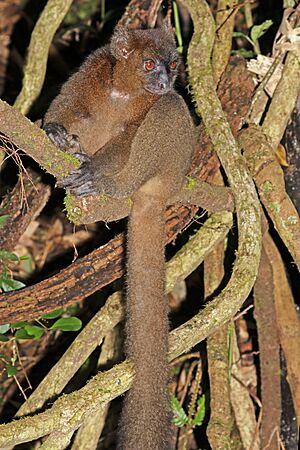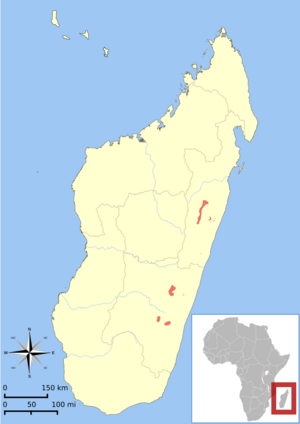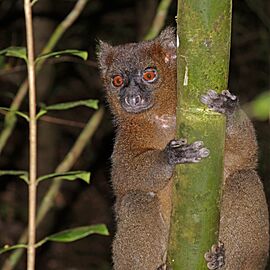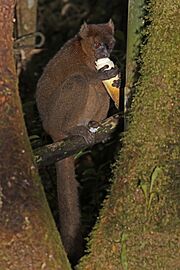Greater bamboo lemur facts for kids
Quick facts for kids Greater bamboo lemur |
|
|---|---|
 |
|
| In Ranomafana National Park | |
| Conservation status | |
| Scientific classification | |
| Genus: |
Hapalemur
|
| Species: |
simus
|
 |
|
| Distribution of H. simus | |
| Synonyms | |
|
|
The greater bamboo lemur (Hapalemur simus) is a special type of lemur that lives only on the island of Madagascar. It is also known as the broad-nosed bamboo lemur or the broad-nosed gentle lemur. This unique animal is critically endangered, meaning it is at a very high risk of disappearing forever.
Contents
About the Greater Bamboo Lemur
The greater bamboo lemur is the biggest of all bamboo lemurs. It weighs over 5 lb (2.3 kg) (about 2.3 kg). Its fur is greyish-brown, and it has white tufts of fur on its ears. From head to body, it measures about 1.5 ft (46 cm) (around 45 cm) long. These lemurs have long tails and strong back legs. This helps them leap vertically through the trees in their forest homes.
What Do Greater Bamboo Lemurs Eat?
Greater bamboo lemurs mostly eat bamboo, especially a type called Cathariostachys madagascariensis. They love the fresh shoots, but also eat the soft inside part (pith) and the leaves.
Bamboo shoots contain a poison called cyanide. Scientists are still trying to figure out how these lemurs can eat so much bamboo without getting sick. The amount of cyanide they eat daily would be enough to harm humans. Sometimes, they also munch on fungi, flowers, and fruit. Their main food source being bamboo is a big reason why they are endangered. Areas with lots of bamboo often have human activity, like people cutting down bamboo illegally.
Where Do They Live?
Today, the greater bamboo lemur lives only in the southeastern part of Madagascar. However, old fossils show that they used to live in much larger areas, even as far north as Ankarana. Some important places where they live now include Ranomafana and Andringitra National Park.
How Do They Behave?
Greater bamboo lemurs live in groups that can have up to 28 members. They are very social animals and enjoy being together. It is thought that the male lemurs might be in charge of the group, which is unusual for lemurs.
Because they are so social, greater bamboo lemurs use at least seven different sounds to talk to each other. Males have been seen taking bamboo pith from females, even if the females worked hard to open the bamboo stems. In zoos, greater bamboo lemurs have lived for more than 17 years.
Who Are Their Predators?
The main animals that hunt greater bamboo lemurs are the fossa and bush pigs. Large birds of prey are also thought to hunt them. Fossas hunt many greater bamboo lemurs.
To stay safe from predators, lemurs need secure places to sleep. They often choose tree holes or build special nests. Scientists believe that choosing safe sleeping spots also helps them avoid parasites and stay warm or cool.
Conservation Status
The greater bamboo lemur is one of the most critically endangered primates in the world. This is according to the IUCN Red List, which tracks endangered species. For a while, scientists even thought this lemur was extinct! But in 1986, a small group of them was found.
Since then, surveys in south and central-eastern Madagascar have found about 500 individuals living in 11 small groups. The area where they live now is much smaller than it used to be, less than 4% of their original habitat.
The main reasons for their endangerment are climate change and human activities. These activities have destroyed their main food source, bamboo. The greater bamboo lemur is an ancient type of primate that appeared even before monkeys. They find it very hard to adapt to their rapidly changing environment.
Human activities like slash and burn farming, mining, cutting down bamboo and other trees, and hunting with slingshots are all threatening this species. The greater bamboo lemur was once listed as one of "The World's 25 Most Endangered Primates."






